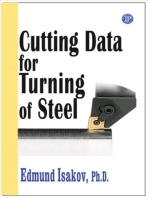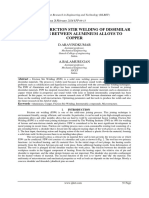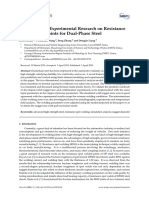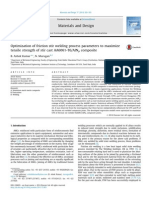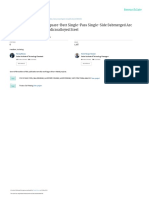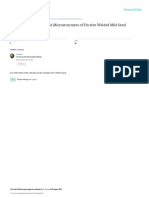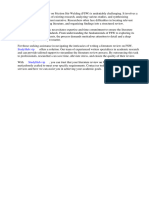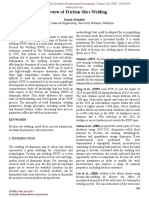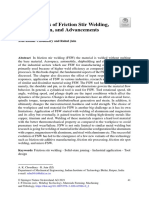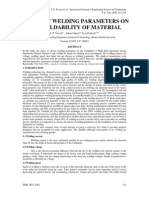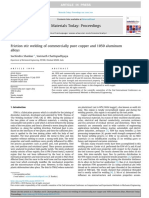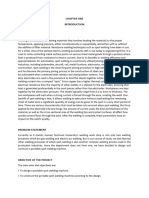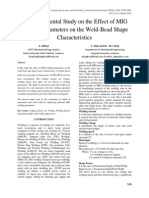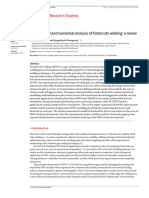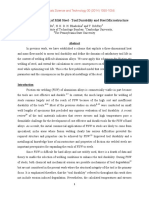Friction Stir Welding of Austenitic Stainless Steels: of Achievements in Materials and Manufacturing Engineering
Friction Stir Welding of Austenitic Stainless Steels: of Achievements in Materials and Manufacturing Engineering
Uploaded by
Usman RasheedCopyright:
Available Formats
Friction Stir Welding of Austenitic Stainless Steels: of Achievements in Materials and Manufacturing Engineering
Friction Stir Welding of Austenitic Stainless Steels: of Achievements in Materials and Manufacturing Engineering
Uploaded by
Usman RasheedOriginal Title
Copyright
Available Formats
Share this document
Did you find this document useful?
Is this content inappropriate?
Copyright:
Available Formats
Friction Stir Welding of Austenitic Stainless Steels: of Achievements in Materials and Manufacturing Engineering
Friction Stir Welding of Austenitic Stainless Steels: of Achievements in Materials and Manufacturing Engineering
Uploaded by
Usman RasheedCopyright:
Available Formats
VOLUME 43 ISSUE 1
of Achievements in Materials and Manufacturing Engineering
November 2010
Friction Stir Welding of austenitic stainless steels
C. Meran*, O.E. Canyurt
Mechanical Engineering Department, Engineering Faculty, Pamukkale University, 20070 Kinikli, Denizli, Turkey * Corresponding author: E-mail address: cmeran@pau.edu.tr
Received 16.09.2010; published in revised form 01.11.2010
Manufacturing and processing
AbstrAct
Purpose: Friction Stir Welding (FSW) was applied austenitic stainless steels that is difficult to weld using FSW technique. Proper weld can be obtained by using appropriate welding parameter. In this paper, the effect of different tool rotational speeds, traverse speeds, compressive tool forces, and tool angles was investigated. Design/methodology/approach: The dimension of 3 mm x 75 mm x 150 mm two stainless steel plates were used and butt welded by FSW method using 7.5 kW vertical head milling machine. All welded test specimens were prepared perpendicular to the weld line in order to determine the mechanical properties and tested with 12 MPa/sec stress rate under stress control using a servo-hydraulic Instron 8801. Microstructure of the welding zone and macrograph of the heat affected zone was investigated by SEM. Findings: The average grain size in the SZ was between 3 and 7 m, which is smaller than that in the BM. The average grain size in the HAZ was about 20 m, which is half of that in the BM.Fine-grained microstructures are present the welded area. The dark bands observed in the weld zone were also detected the microstructure of the transition zone. Dark and narrow bands do not consist of pores or cavities. It was determined that these bands do not process an ultra fine-grained microstructure. They are Cr2O3 oxide layers which over the surface of stainless steels may have been ruptured during friction stir welding and may form bands inside the welding bead due to stirring. Research limitations/implications: The proper cooling system helps to prevent the stirrer tool from the deformation. Practical implications: The strength of the welded zone of AISI 304 stainless steel can be easily found by implementing welding design parameters and high quality joints can be obtained. Originality/value: This study was performed in the frame of the TUBITAK project no 106M504, Friction Stir Weldability of Stainless Steels and Investigation of the Affected Parameters on the Welding Quality. Keywords: Friction Stir Welding; AISI 304; Stainless steel; Rotational tool speed; Traverse speed Reference to this paper should be given in the following way: C. Meran, O.E. Canyurt, Friction Stir Welding of austenitic stainless steels, Journal of Achievements in Materials and Manufacturing Engineering 43/1 (2010) 432-439.
1. Introduction 1. Introduction
Friction stir welding (FSW) is a solid-state joining process developed and patented by The Welding Institute (TWI) in UK
in 1991[1]. In early years, it was introduced for light alloys. Recently, high performance tool materials are employed for FSW of high melting temperature materials such as titanium, nickel and steels. The process is based on heating the weld area by friction created by a rotating tool. The softened metal
432
Research paper
Copyright by International OCSCO World Press. All rights reserved. 2010
Manufacturing and processing
followed by giving the tool a forward movement to mix it by using a tool tip, which creates the welding. Because melting of the attached components do not occur, and therefore welding can be carried out easily in every position. In addition, the metals like copper, aluminum, magnesium and their alloys which are difficult to weld by performing conventional welding techniques, can be welded easily using this method. Non-consumable, rotating tools of various designs produced from different materials showing superior characteristics under high temperatures and pressures are suitable for this technique. The most disadvantage of FSW technique is the formation of pores and voids when not the proper welding parameters will be applied during the operation. In general, these failures occur in the welding bead. Another disadvantage, as aforementioned, is the difficulty of joining metals with high melting temperatures. Special tools that can preserve their hardness under high temperature conditions and powerful welding machines are required for welding refractory metals and alloys. Friction stir weldability of metals can be affected by many factors. The most important ones are: tool rotational and traverse speed, compressive tool force, tilt angle and plunge depth, tool tip length and diameter, and tool shoulder profile, respectively. The improvement of the friction stir weld (microstructure and mechanical properties) is dependent on the controlling the above mentioned process parameters [2-5]. It is well known that the studies on FSW of stainless steels are relatively restricted compared to those on materials having low melting points such as Aluminum and its alloys. Early research conducted on FSW using stainless steels indicated that the weldability is primarily depending on the welding parameters [6-13]. Material flow during friction stir welding is very complex and not fully understood. Most of studies in literature used threaded pins since most industrial applications currently use threaded pins. However, initially threaded tools may become unthreaded because of the tool wear when used for high melting point alloys or reinforced aluminum alloys. The material flow path of friction stir welding process using unthreaded tools were studied [14]. Material flow with unthreaded pin was found to have the same features as material flow using classical threaded pins. The product of the plunge force and the rotational speed was found to affect the size of the shoulder dominated zone. This effect is reduced using the cylindrical tapered pin with flats [14]. For FSW, both tool rotation rate and traverse speed exert a significant effect on the thermal input and mechanical properties. It was reported that the peak temperature in the FSW zone increases with increasing tool rotation rate [15]. It was found that rotational speed had a significant impact on microstructure and mechanical properties of the joints for Ti6Al4V titanium alloy. Joints were produced by employing rotational speeds ranging from 400 to 600 rpm at a constant welding speed of 75 mm/min. It was found that the hardness in the weld zone was lower than that in the base material, and decreased with increasing rotational speed. Results of transverse tensile test indicated that all the joints exhibited lower tensile strength than the base material and the tensile strength of the joints decreased with increasing rotational speed [16]. Zhang and Zhang [17] analyzed the effect of
transverse speed on friction stir welding in detail for the controlling of this parameter by using a fully coupled thermomechanical model. It was found that when the transverse speed is higher, the stirring effect of the welding tool becomes weaker, which is the reason for the occurrence of weld flaw. When the transverse speed is increased, the contribution of the plastic deformation to the temperature rise is increased. But the variation of the transverse speed does not significantly affect the power needed for FSW [17]. Numerical results indicate that the maximum temperature in the FSW process can be increased with the increase of the rotating speed. Both the increase of the rotating speed and the decrease of the welding speed can lead to the increase of the stirring effect of the welding tool, which can improve the friction stir weld quality. When the welding speed becomes higher, the rotating speed must be increased simultaneously to avoid any possible welding defects such as void [18]. Friction stir tool is the key art of friction stir welding process. The geometry of the pin affects the heat generation and the flow of the plastic material. Eventually, the pin can affect the shape and the mechanical properties of the weld [19-23]. Literature studies also suggest that the stirring tool material is one of the topics widely studied on friction stir welding of high melting point materials such as stainless steels. The tool material is expected to possess the desired hardness, high stiffness and sufficient wear resistance 1000 C or at higher temperatures. Researchers studying this topic have used wolfram base alloys, specifically W-Re alloys, molybdenum alloys and polycrystalline cubic boron nitrides (PCBN) as tool materials. The behavior of the tool materials during welding was examined in various studies [24-27]. Nandan et al. mathematically modeled the flow and heat distribution that is formed during the three dimensional friction stir welding process of stainless steels. The numerical results were in good agreement with that of the experiments [28]. Numerical models have been developed for friction stir welding of stainless steels in terms of a visco plastic material behavior. Heat distribution and flow directions were examined [29]. Friction stir welding of steel pipes were carried out using PCBN tools with 25 mm in diameter and 5.5 mm in length by applying 500 600 rpm rotational speed and 100 -150 mm/min traverse speed. Different from similar studies, compressive tool force, that is a very important parameter for friction stir welding, has been kept constant at 10 kN during welding. In order, to prevent oxidation of the weld zone, a protecting argon gas atmosphere is necessary to cover the welding bead [30]. It has been observed that when the mixer tool temperature exceeds 1000C and the compressive tool force was not correctly chosen, weld grooves were formed at the edge of the welding bead [31]. Similarly, the measurements performed by using thermo couples and infrared cameras showed that the tool shoulder temperature higher than 1000 C [32]. It has been determined that by preheating the metals of high melting temperatures such as steels, before friction stir welding, the traverse speed can be increased. This results in a decrease of the tool wearing [33]. In this study, the effect of welding process parameters on the performances of FSW was investigated. Suitable tool rotational and traverse speeds, compressive tool force and tool
READING DIRECT: www.journalamme.org
433
Journal of Achievements in Materials and Manufacturing Engineering
Volume 43 Issue 1 November 2010
angle were determined in FSW of AISI 304 austenitic stainless steel. The best appearance (with surface and root penetrations, having no crevices, cracks or pores), good welding beads with improved mechanical properties can be obtained by the determination of the tool traverse speeds related to the tool rotational speeds, compressive tool force and tool angle.
WC 6% Co) were used during welding process. The tools were cooled by pressurized air during welding in order to extend their life. Friction stir welding process parameters are presented with tensile test results, and upper view of welded joint in Table 3. Table 1. The concentrations of the main elements of the AISI 304 stainless steel are given in mass % C Mn Si Cr Ni P S 0.08 2 1 18-20 8-10.5 0.045 0.03 Table 2. Mechanical properties of the AISI 304 stainless steel at room temperature Density E Rm Rp0.2 A Hardness (g/cm3) (GPa) (MPa) (MPa) (%) (HRB) 8 193 515 205 40 88 Three friction stir welded specimens with dimensions 3 mm x 150 mm x 150 mm were machined for tensile tests. All welded test specimens were prepared perpendicular to the weld line in order to determine the mechanical properties. The specimens were subjected to quasi static and mostly monotonic tension loading. All the tests were performed with 12 MPa/sec stress rate under stress control using a servo-hydraulic Instron 8801 universal uni-axial testing machine with a load capacity of 50 kN. Stress control mode was chosen over stroke or strain mode due to the convenience and smoothness of the operation. Microstructural examination was performed in order to check weld defects such as porosity, coarse dendrites etc. or poor penetration in the welding bead, and the grain structure of the heat-affected zone.
2. Materials method 2. Materials and and method
Experiments in this study were performed in the FSW and Mechanics laboratory at the Department of Mechanical Engineering, Pamukkale University. The dimension of 3 mm x 75 mm x 150 mm two stainless steel plates were used and butt welded by FSW method using 7.5 kW vertical head milling machine. The experimental setup was shown in Fig. 1.
Fig. 1. Experimental setup using for friction stir welding The temperature was obtained by only one fixed location. Temperature of the bottom surface of the joined materials was measured on the fixed location close to the start point hole by using K-type thermocouple that was placed on the bottom fixing plate shown in Fig. l. Compressive tool force is one of the important parameter that controlled the heat input to the welding zone during friction stir welding. Heating rate is depend on compressive tool force that was obtained by milling machine. The compressive tool force was measured by using two load cells located under bottom fixing plate that has the capacity of 10 tones, during entire welding operation and the data transferred to computer, Fig. 1. In the performed studies AISI 304 (X5CrNi18-10, material identification number 1.4301) austenitic stainless steel plates with the chemical composition given in Table 1 and mechanical properties given in Table 2 were used. Two specimens in butt position with the dimensions of 3 mm x 75 mm x150 mm were joined by using FSW with different welding parameters. Initial holes were drilled into the specimens. Equilateral triangle tip profile with 5 mm in diameter and 2.8 mm in height, and end mill cutter shank with 16 mm shoulder diameter (cemented carbide specifications: K10, 94%
3. results discussion 3. Results and and discussion
3.1. the effect of tool rotational speed on 3.1. The effect of the the tool rotational speed on the the weld performance weld performance
The results of tensile tests are given in Table 3. Values given in the Table 3 indicate the average of at least three tests. The effect of the rotational speed on specimens welded with the same traverse speed (60 mm/min), compressive tool force of 9 kN and tool tilt angle of 1.5 were examined. Fig. 2, shows a significant decrease in strength of the material weld zone at values of the rotational speed of below 750 rpm and above 1180 rpm, respectively. At lower rotational speed of 600 rpm, the heat required for softening the weld zone have not been achieved, therefore these results in a decrease of the weld strength. The good quality welding joint can be achieved with the proper softening temperature on the welding zone by supplying the proper combination compressive tool force, tool angle, rotational and traverse speed. The quality mixture of the joined parts microstructure results in an increase of the strength of welded joints. While, the low heat input in the welding zone result in insufficient softened materials that could cause to the porosity and low penetration, the excessive heat input result in the burr built up at the welding bead edges and also decrease the welding cross-section. Therefore, insufficient and excessive heat input result in the decrement on the tensile strength.
434
Research paper
C. Meran, O.E. Canyurt
Manufacturing and processing
Table 3. Friction stir welding process parameters, tensile test results, and upper view of welded joint
The maximum strength of the weld zone was obtained at 950 rpm tool rotational speed with a traverse speed of 60 mm/min, compressive tool force of 9 kN and tool tilt angle of 1.5 . The tensile strength of the weld zone was determined to be 430 MPa, when applying 950 rpm rotational speed, whereas the tensile strength of the base material (Rm=505 MPa). The maximum tensile strength decreased of about 30.23 % and 42.7 %
when the rotational speed was dropped from 950 rpm to 600 rpm or raised up to 1500 rpm respectively. In the weld zone the finegrained microstructure was observed and the tensile strength of the welded joint was found higher than that of the base material. It is obvious that the best macroscopic appearance was achieved in the weld joints produced with 950 and 1180 rpm rotational speeds. The welding burr built up at the welding bead edges occurred at 1180 rpm rotational speed. Therefore, the
Friction Stir Welding of austenitic stainless steels
435
Journal of Achievements in Materials and Manufacturing Engineering
Volume 43 Issue 1 November 2010
determined values of the tensile tests is slightly lower than the values of the tensile strength performed with 950 rpm. The lower and higher values of rotational speeds cause in sufficient penetration and quality of the welding. The lower (< 600 rpm) tool rotational speeds result in an insufficient source generation and the higher (> 1500 rpm) rotational tool speeds result in an excessive heat generation. Both process conditions parameters cause crevices and insufficient penetration in the welding bead.
500 450 400 350 300 250 200 150 100 50 0 400 Tensile Strength (MPa) 950 1180
550 Tensile Strength (MPa) 500 450 400 350 300 250 200 150 100 30 35 40 45 50 55 60 65
Traverse Speed (mm/min)
750 600
1500
Fig. 3. Influence of the traverse speed on the tensile strength with FSW joints having n=750 rpm, F=9 kN, =1.5
600
800
1000 Revolutions n (rpm)
1200
1400
1600
3.3. the effect of the compressive on 3.3 The effect of the compressive tool force tool force on the weld performance the weld performance
Compressive force influences the welded strength of the joined parts. As shown in Fig. 4, the change of compressive force from 5 to 7 kN leads to a sharp raise in the strength value from 273 MPa to 479 MPa and the change of compressive force from 7 to 9 kN leads to a drop the strength value from 479 MPa to 421 MPa.
500 Tensile Strength (MPa) 450 400 350 300 250 200 150 100 4 5 6 7 8 9 10
Fig. 2. The effect of the rotational tool speed on tensile strength of AISI 304 stainless steel processed by FSW with process parameters: vt=60 mm/min, F=9 kN, =1.5
3.2. the effect of traverse on the weld 3.2 The effect of traverse speed speed on the weld performances
performances
The good quality weld zone can be achieved with the proper softening temperature on the welding zone. The traverse speed has effect on the temperature of the weld zone. The rotational shoulder and pin does not have enough time to heat the welding zone with higher the traverse speeds or too much heat on welding zone with lower traverse speeds. Therefore, there is an optimum value of the traverse speed in order to obtain quality joints. The welding parameters were taken from Table 3. The same procedure with varying rotational speed was performed for the traverse speed. The compressive tool force of 9 kN was kept constant in the beginning of the welding, then the tool started and proceeded along the welding seam. The effect of the traverse speed on the performance and mechanical properties of the welded specimens processed with the constant rotational speed (750 rpm), compressive tool force of 9 kN and tool tilt angle of 1.5 were examined. The maximum tensile strength of the weld zone was achieved by applying traverse speed of 47.5 mm/min, that is an optimum value with a rotational speed of 750 rpm, the compressive tool force of 9 kN and tool tilt angle of 1.5 as shown in Fig. 3. The lower and higher values of 47.5 mm/min cause a decrease in strength of the weld zone. The tensile strength increased from 470 MPa to 484 MPa due to an incremental increase of the traverse speed from 37.5 mm/min to 47.5 mm/min, respectively. When the traverse speed was raised from 47.5 mm/min to 60 mm/min, the tensile strength decreased 18.5% (484 MPa to 395 MPa Table 3). The macroscopic appearances of the friction stir welded joints using different traverse of the tool are illustrated in Table 3. The best appearance revealed the weld joints processed with 47.5 mm/min traverse speed. Crevices were determined on the welds produced with a traverse speed of 60 mm/min.
Compressive Force (kN)
Fig. 4. Influence of the compressive tool force on the tensile strength with FSW joints having n=1180 rpm, vt= 60 mm/min, =1.5
3.4 The effect of the tool tilt angle on angle 3.4. the effect of the tool tilt the weld on the performance weld performance
The strength of welded joints was affected from the tool tilt angle. The angle of 0o causes a serious problem in the weld areas. Small increment on the tilt angle helps to increase the joint strength until the tilt angle of 2 degrees. An optimum tilt angle was obtained at 2 degrees, lower and higher tilt angle cause a decrement on the joint strength. The joint strength was increased 71.34 % by selection of 2 degrees instead of 0 degrees shown in Fig. 5. It can be seen that design parameters have an influence on the strength of the welded joints. Selection of proper FSW design parameters result in an increase of the joint strength.
436
Research paper
C. Meran, O.E. Canyurt
Manufacturing and processing
The microstructure of the weld zone is finer when compared to that of the base material. The grain size of the base material that is thermo mechanically affected and dynamically recrystallized is decreased. Microstructural examinations exhibit the weld zone (stir zone) the grain sizes are considerably fine. In addition, the grains of the weld zone are equiaxed and the grain size decreases gradually in the heat affected zone, Fig. 6. The distribution of the average grain size is more or less uniform in the stir zone, although the advancing side has a slightly larger grain size than the retreating side. The average grain size in the SZ ranges between 3 and 7 m, which is smaller than that in the BM. The average grain size in the HAZ was determined to be about 20 m, which is half of that in the BM. The microstructure of the transition zone between the base material and the weld zone is different from the microstructures of both of the regions. The dark bands observed in the weld zone were also detected the microstructure of the transition zone, see Fig. 6b.
pores or cavities. The SEM study showed, it was determined that these bands do not process an ultra fine-grained microstructure. They are Cr2O3 oxide layers which over the surface of stainless steels may have been ruptured during friction stir welding and may form bands inside the welding bead due to stirring [36].
4. conclusions 4. Conclusions
The studies on friction stir welding (FSW) of stainless steels are not as comprehensive as those ones conducted on aluminum due to the some limitation and the high cost of tool material and the requirement of powerful milling machine. The following important conclusions will be drawn from the results of the present study: Several tool tip profiles as parameters were examined in the experimental study. Hard metal carbide tools (K10, 94% WC 6% Co) with triangular tool tip profiles are suitable for friction stir welding of AISI 304 austenitic stainless steels. The maximum tensile strength in friction stir welded AISI 304 material produced with 950 rpm rotational speeds and 60 mm/min traverse speed, 9 kN compressive tool force, and 1.5 tool tilt angle the weld zone was determined to be as 430 MPa for the same process parameters while the tensile strength of the base material is 505 MPa. Fine-grained microstructures are present the welded area. From this it is concluded that the weld joints obtained by friction stir welding have higher tensile strength compared to that of the base material. The average grain size in the SZ was between 3 and 7 m, which is smaller than that in the BM. The average grain size in the HAZ was about 20 m, which is half of that in the BM. The dark bands observed in the weld zone were also detected the microstructure of the transition zone. These dark and narrow bands do not consist of pores or cavities. It was determined that these bands do not process an ultra finegrained microstructure. They are Cr2O3 oxide layers which over the surface of stainless steels may have been ruptured during friction stir welding and may form bands inside the welding bead due to stirring.
500 Tensile Strength (MPa) 450 400 350 300 250 200 150 100 0 0,5 1 1,5 2 2,5 3 3,5
Tool Tilt Angle ( o )
Fig. 5. Influence of the tool tilt angle on the tensile strength with FSW joints having n=1180 rpm, vt= 60 mm/min, F=9 kN
Acknowledgements Acknowledgments
This study was performed in the frame of the TUBITAK project no 106M504, "Friction Stir Weldability of Stainless Steels and Investigation of the Affected Parameters on the Welding Quality". The authors would express their thanks to TUBITAK for their kindly supports.
Fig. 6. Macrograph of the heat affected zone (HAZ) (a), weld zone (b) and base material (c), optical micrographs showing the microstructures of the stir welded zone processed with F=9 kN, vt=60 mm/min, n= 950 rpm, =1.5 The literature survey Ref. [34-35] reveals that some of the investigators claimed that these bands possess an ultra finegrained microstructure due to recrystallization followed by severe cold working. These dark and narrow bands do not consist of
references References
[1] W.M. Thomas, Friction stir butt welding, International Patent Appl. No. PCT/GB92/02203 and GB Patent Appl. No.9125978.8, US Patent No. 5460, 317, 1991.
Friction Stir Welding of austenitic stainless steels
437
Journal of Achievements in Materials and Manufacturing Engineering
Volume 43 Issue 1 November 2010
[2]
[3]
[4]
[5]
[6]
[7]
[8] [9]
[10] [11] [12]
[13]
[14]
[15]
[16]
M.M. Attallah, H.G. Salem, Friction stir welding parameters: a tool for controlling abnormal grain growth during subsequent heat treatment, Materials Science and Engineering A 391/1-2 (2005) 51-59. K.A.A. Hassan, P.B. Prangnell, A.F. Norman, D.A. Price, S.W. Williams, The Effect of Welding Parameters on the Nugget Zone Microstructure and Properties in High Strength Al-Alloy Friction Stir Welds, Science and Technology of Welding and Joining 8 (2003) 257-268. Y.G. Kim, H. Fujii, T. Tsumura, T. Komazaki, K. Nakara, Effect of welding parameters on microstructure in the stir zone of FSW joints of aluminum die casting alloy, Materials Letters 60 (2006) 3830-3837. A.P. Reynolds, W. Tang, Z. Khandkar, J.A. Khan, K. Lindner, Relationships among weld parameters, hardness distributions, and temperature histories in alloy 7050 friction stir welds, Science and Technology of Welding and Joining 10 (2005) 190-199. T. Saeid, A. Abdollah-Zadeh, H. Assadi, F.M. Ghaini, Effect of friction stir welding speed on the microstructure and mechanical properties of a duplex stainless steel, Materials Science and Engineering A 496 (2008) 262-268. T. Ishikawa, H. Fujii, K. Genchi, S. Iwaki, S. Matsuoka, K. Nogi, High Quality-High Speed Friction Stir Welding of 304 Austenitic Stainless Steel, Journal of the Iron and Steel Institute of Japan 94-11 (2008) 539-544. C. Meran, V. Kovan, A. Alptekin, Friction stir welding of AISI 304 austenitic stainless steel, Materialwissenschaft und Werkstofftechnik 38 (2007) 829-835. Y.S. Sato, T.W. Nelson, C.J. Sterling, R.J. Steel, C.O. Pettersson, Microstructure and mechanical properties of friction stir welded SAF 2507 super duplex stainless steel, Materials Science and Engineering A 397 (2005) 376-384. Y.S. Sato, T.W. Nelson, C.J. Sterling, Recrystallization in type 304L stainless steel during friction stirring, Acta Materialia 53 (2005) 637-645. A.P. Reynolds, W. Tang, M. Posada, J. Deloach, Friction stir welding of DH36 steel, Science and Technology of Welding and Joining 8/6 (2003) 455-460. S.H.C. Park, S. Yutaka, H. Kokawa, K. Okamoto, S. Hirano, M. Inagaki, Rapid formation of the sigma phase in 304 stainless steel during friction stir welding, Scripta Materialia 49 (2003) 1175-1180. A.P. Reynolds, M. Posada, J. Deloach, M.J. Skinner, J. Halpin, T.J. Lienert, FSW of austenitic stainless steels, Proceedings of the 3rd International Symposium Friction Stir Welding, Kobe, Japan, 2001. O. Lorrain, V. Favier, H. Zahrouni, D. Lawrjaniec, Understanding the material flow path of friction stir welding process using unthreaded tools, Journal of Materials Processing Technology 210 (2010) 603-609. S.R. Ren, Z.Y. Ma, L.Q. Chen, Effect of welding parameters on tensile properties and fracture behavior of friction stir welded AlMgSi alloy, Scripta Materialia 56 (2007) 69-72. L. Zhou, H.J. Liu, Q.W. Liu, Effect of rotation speed on microstructure and mechanical properties of Ti6Al4V
[17] [18] [19]
[20] [21] [22]
[23]
[24] [25] [26] [27] [28]
[29]
[30] [31] [32]
friction stir welded joints, Materials and Design 31/5 (2010) 2631-2636 Z. Zhang, H.W. Zhang, Numerical studies on the effect of transverse speed in friction stir welding, Materials and Design 30/3 (2009) 900-907. Z. Zhang, H.W. Zhang, Numerical studies on controlling of process parameters in friction stir welding, Journal of Materials Processing Technology 209/1 (2009) 241-270. Y.H. Zhao, S.B. Lin, L. Wu, F. Xing Qu, The influence of pin geometry on bonding and mechanical properties in friction stir weld 2014 Al alloy, Materials Letters 59/23 (2005) 2948-2952. R.A. Prado, L.E. Murr, D.J. Shindo, Tool wear in the friction-stir welding of aluminum alloy 6061+20% Al2O3: a preliminary study, Scripta Materialia 45/1 (2001) 75-80. M. Boz, A. Kurt, The influence of stirrer geometry on bonding and mechanical properties in friction stir welding process, Materials and Design 25/4 (2004) 343-347. R.A. Prado, L.E. Murr, D. J. Shindo, K.F. Soto, Selfoptimization in tool wear for friction-stir welding of Al 6061+20% Al2O3 MMC, Materials Science and Engineering A 349/1-2 (2003) 156-165. K. Elangovan, V. Balasubramanian, Influences of tool pin profile and tool shoulder diameter on the formation of friction stir processing zone in AA6061 aluminium alloy, Materials and Design 29 (2008) 362-373. T.J. Lienert, W.L. Stellwag, J. Grimmett, R.W. Warke, Friction Stir Welding Studies on Mild Steel, Welding Journal Research Supplement 82/1 (2003) 1-9. P.J. Konkol, J.A. Mathers, R. Johnson, J.R. Pickens, Friction Stir Welding of HSLA-65 Steel for Shipbuilding, Journal of Ship Production 19/3 (2003) 159-164. H. Liu, L. Zhou, Progress in friction stir welding of high melting point materials, Transactions of the China Welding Institution 28 (2007) 101. R. Nandan, G.G. Roy, T.J. Lienert, T. Debroy, Threedimensional heat and material flow during friction stir welding of mild steel, Acta Materialia 55/3 (2007) 883-895. J.H. Cho, D.E. Boyce, P.R. Dawson, Modeling strain hardening and texture evolution in friction stir welding of stainless steel, Materials Science and Engineering A 398 (2005) 146-163. C.J. Sterling, T.W. Nelson, C.D. Sorensen, R.J. Steel, S.M. Packer, in: K.V. Jata, M.W. Mahoney, R.S. Mishra, S.L. Semiatin, T. Lienert, (Eds.), Friction Stir Welding and Processing II, 2003, 165. T.J. Lienert, J.E. Gould, in: Proceedings of the First International Symposium on Friction Stir Welding, California, 1999. W.M. Thomas, P.L. Threadgill, E.D. Nicholas, Feasibility of Friction Stir Welding Steel, Science and Technology of Welding and Joining 4/6 (1999) 365-372. H. Kokawa, S.H.C. Park, Y.S. Sato, K. Okamoto, S. Hirano, M. Inagaki, Microstructural Evolution of 304 Austenitic Stainless Steel during Friction Stir Welding, Proceedings of Friction Stir Welding Symposium at the 14th International Society of Offshore and Polar Engineers Conference, ISOPE 2004, Toulon, France, 2004, vol. 4, 73-77.
438
Research paper
C. Meran, O.E. Canyurt
Manufacturing and processing
[33] R.S. Mishra, Z.Y. Ma, Friction stir welding and processing, Materials Science and Engineering: R: Reports 50/1-2 (2005) 1-78. [34] S.H.C. Park, Y.S. Sato, H. Kokawa, K. Okamoto, S. Hirano, M. Inagaki, Corrosion resistance of friction stir welded 304 stainless steel, Scripta Materialia 51 (2004) 101-105. [35] M. Posada, J. Deloach, A.P. Reynolds, J.P. Halpin, in: K.V. Jata, M.W. Mahoney, R.S. Mishra, S.L. Semiatin,
D.P. Filed (Eds.), Friction Stir Welding and Processing, Warrendale, PA, USA, 2001, 159. [36] C. Meran, O.E. Canyurt, Evaluation of Microstructure in Friction Stir Welded Austenitic Stainless Steels, Proceedings of the 63rd Annual Assembly and International Conference of the International Institute of Welding, Istanbul, Turkey, 2010, 853-857.
Friction Stir Welding of austenitic stainless steels
439
You might also like
- An Overview of Friction Stir Welding (FSW) : A New PerspectiveDocument4 pagesAn Overview of Friction Stir Welding (FSW) : A New PerspectiveinventyNo ratings yet
- Aeletters 2023 8 2 3Document10 pagesAeletters 2023 8 2 3miskoscribdNo ratings yet
- Research Paper FSWDocument10 pagesResearch Paper FSWsahith palikaNo ratings yet
- Latest Developments in Friction Welding - A ReviewDocument6 pagesLatest Developments in Friction Welding - A ReviewIJRASETPublicationsNo ratings yet
- Low Cost Friction Stir Welding A ReviewDocument10 pagesLow Cost Friction Stir Welding A ReviewWeld TechNo ratings yet
- A Review On Process Parameters and Their Effects oDocument7 pagesA Review On Process Parameters and Their Effects oVeerendraChitturiNo ratings yet
- Effects of Friction Welding Parameters On The Mechanical Properties of Dissimilar Steel JointsDocument7 pagesEffects of Friction Welding Parameters On The Mechanical Properties of Dissimilar Steel Jointsollata kalanoNo ratings yet
- E3sconf Icmed2020 01030Document6 pagesE3sconf Icmed2020 01030Isaac SimbañaNo ratings yet
- Pin Design 2Document18 pagesPin Design 2palash roy choudhuryNo ratings yet
- Summary FSWDocument26 pagesSummary FSWhazelmyaNo ratings yet
- Effect of Welding Parameters On Mechanical PropertDocument12 pagesEffect of Welding Parameters On Mechanical PropertBaibhav VikasNo ratings yet
- A Review On Friction Stir Welding of Dissimilar Materials Between Aluminium Alloys To CopperDocument7 pagesA Review On Friction Stir Welding of Dissimilar Materials Between Aluminium Alloys To CopperInternational Journal of Latest Research in Engineering and TechnologyNo ratings yet
- Final ProjDocument107 pagesFinal ProjNaveen KumarNo ratings yet
- ÖDEV Materials-12-01108Document16 pagesÖDEV Materials-12-01108Serkan APAYNo ratings yet
- A Study of Effect Process Parameters On Tensile StrengthDocument9 pagesA Study of Effect Process Parameters On Tensile StrengthAnil ChauvanNo ratings yet
- Experimental Study On Square-Butt Single-Pass Single-Side Submerged Arc Welding of Low-Carbon Microalloyed SteelDocument19 pagesExperimental Study On Square-Butt Single-Pass Single-Side Submerged Arc Welding of Low-Carbon Microalloyed SteelSk ShankarNo ratings yet
- Impact of Pin Tool Designs On The Mechanical Properties and Microstructure of Aluminum Alloys AA7075 - AA6061Document12 pagesImpact of Pin Tool Designs On The Mechanical Properties and Microstructure of Aluminum Alloys AA7075 - AA6061bikashmohantyreal99No ratings yet
- Effect of Friction Stir Welding Parameters On Impact Strength of The Az31 Magnesium Alloy JointsDocument8 pagesEffect of Friction Stir Welding Parameters On Impact Strength of The Az31 Magnesium Alloy JointsTJPRC PublicationsNo ratings yet
- Friction Stir Welding ReportDocument16 pagesFriction Stir Welding ReportjishnuNo ratings yet
- Investigations Into FSW Joints of Dissimilar Aluminum Alloys - ScienceDirectDocument6 pagesInvestigations Into FSW Joints of Dissimilar Aluminum Alloys - ScienceDirectpicul 08No ratings yet
- Friction Stir Welding Process Parameters Significance and Impact On Metal Matrix Composites Joints: A Brief ReviewDocument12 pagesFriction Stir Welding Process Parameters Significance and Impact On Metal Matrix Composites Joints: A Brief ReviewPerumalla Janaki RamuluNo ratings yet
- Friction Stir Welding of Aluminium Alloys: Submitted by Manoj Balu V B Roll No: 135506Document13 pagesFriction Stir Welding of Aluminium Alloys: Submitted by Manoj Balu V B Roll No: 135506Anonymous AdofXEYAgENo ratings yet
- Friction Stir Welding JournalDocument11 pagesFriction Stir Welding JournalSahil JaggiNo ratings yet
- Study of Tool Geometry On Friction Stir Welding of Aa 6061 and Az61Document7 pagesStudy of Tool Geometry On Friction Stir Welding of Aa 6061 and Az61Osama MohammedNo ratings yet
- Optimization of Friction Stir Welding PR PDFDocument7 pagesOptimization of Friction Stir Welding PR PDFJefferson SegundoNo ratings yet
- Optimizing Tensile Strength of Low-Alloy Steel Joints in Upset WeldingDocument5 pagesOptimizing Tensile Strength of Low-Alloy Steel Joints in Upset Weldingabraham silva hernandezNo ratings yet
- Jurnal KEM.948.33 M. Ziyad, FMDocument7 pagesJurnal KEM.948.33 M. Ziyad, FMZinsaisal BakriNo ratings yet
- A Review Paper On Effect of Varying Welding Heat Input On Microstructure, Mech Properties and Corrosion Behaviors of Ferritic SS & Mild Steel PDFDocument5 pagesA Review Paper On Effect of Varying Welding Heat Input On Microstructure, Mech Properties and Corrosion Behaviors of Ferritic SS & Mild Steel PDFMursidil KamilNo ratings yet
- JSP1265SSWPAPERFeb O9Document19 pagesJSP1265SSWPAPERFeb O9Hussain AlsaadyNo ratings yet
- Friction Stir Welding of Aluminium AlloysDocument13 pagesFriction Stir Welding of Aluminium AlloysAnonymous AdofXEYAgENo ratings yet
- Heat Transfer Analysis During Friction Stir Welding of Al6061-T6 AlloyDocument8 pagesHeat Transfer Analysis During Friction Stir Welding of Al6061-T6 AlloyfabiskrujaNo ratings yet
- Influence of Welding Current and Joint DDocument6 pagesInfluence of Welding Current and Joint Dlemuelbornasal12No ratings yet
- Microstructure and Mechanical Properties of Resistance Upset Butt Welded 304Document11 pagesMicrostructure and Mechanical Properties of Resistance Upset Butt Welded 304Ashkaan OzlatiNo ratings yet
- Mechanical Properties and Microstructures of Friction Welded Mild SteelDocument10 pagesMechanical Properties and Microstructures of Friction Welded Mild SteelIr. Iis Siti Aisyah, S.T., M.T., Ph.DNo ratings yet
- Experimental Investigation of Resistance Spot Welding of Duplex Stainless SteelDocument5 pagesExperimental Investigation of Resistance Spot Welding of Duplex Stainless SteelM.SoundarrajanNo ratings yet
- Review Paper On Optimization of Metal Inert Gas Welding On Stainless Steel AISI 410by Taguchi MethodDocument8 pagesReview Paper On Optimization of Metal Inert Gas Welding On Stainless Steel AISI 410by Taguchi MethodIJRASETPublicationsNo ratings yet
- Materials Science and Engineering ADocument9 pagesMaterials Science and Engineering AСергей СкргейNo ratings yet
- Project11 THDocument23 pagesProject11 THsidharthrana046No ratings yet
- Mechanical Properties and Microstructures of Friction Welded Mild SteelDocument10 pagesMechanical Properties and Microstructures of Friction Welded Mild SteelM Khoirul AnamNo ratings yet
- Numerical and Experimental Evaluation of Bending Test of Friction Stir Welded of Brass AlloyDocument9 pagesNumerical and Experimental Evaluation of Bending Test of Friction Stir Welded of Brass AlloySameer SonuNo ratings yet
- Literature Review of Friction Stir WeldingDocument8 pagesLiterature Review of Friction Stir Weldingc5rh6ras100% (1)
- A Review of Friction Stirs WeldingDocument6 pagesA Review of Friction Stirs WeldingEditor IJTSRDNo ratings yet
- 10452-Article Text-38608-44007-10-20240930Document21 pages10452-Article Text-38608-44007-10-20240930Ashish TomNo ratings yet
- Fundamentals of Friction Stir Welding, Its Application, and AdvancementsDocument50 pagesFundamentals of Friction Stir Welding, Its Application, and Advancementsjose ramirez cruzNo ratings yet
- AISI 430 Ferritic Stainless Steel MicrostuctureDocument7 pagesAISI 430 Ferritic Stainless Steel MicrostuctureAid Farhan MaarofNo ratings yet
- Safeen 2016Document17 pagesSafeen 2016Khawaja TaimoorNo ratings yet
- Nik Weld ParameterDocument5 pagesNik Weld ParameterHarmish BhattNo ratings yet
- Materials Today: Proceedings: Sachindra Shankar, Somnath ChattopadhyayaDocument4 pagesMaterials Today: Proceedings: Sachindra Shankar, Somnath ChattopadhyayaPratikraj GohilNo ratings yet
- A PORTABLE SPOT-WELDING MACHINE Chap 1 Ad 2Document16 pagesA PORTABLE SPOT-WELDING MACHINE Chap 1 Ad 2robertntsiful1No ratings yet
- Processes 08 00811Document32 pagesProcesses 08 00811أبومحمدالزياتNo ratings yet
- An Experimental Study On The Effect of MIGDocument4 pagesAn Experimental Study On The Effect of MIGBhramandhikaNalendraGhuptaNo ratings yet
- WT ReportDocument18 pagesWT ReportmariaantonyvargheesmichaeljoelNo ratings yet
- Effect of Weld Parameters On Mechanical Properties of The Friction Stir Welding Aa6063-T5Document9 pagesEffect of Weld Parameters On Mechanical Properties of The Friction Stir Welding Aa6063-T5HUỲNH HOÀNG TÚNo ratings yet
- 8th Sem Project ReportDocument55 pages8th Sem Project ReportPrathmeshBhokari100% (2)
- LBW OptimizationDocument11 pagesLBW Optimizationfathi.alfazaniNo ratings yet
- Sen_2022_Eng._Res._Express_4_032004Document11 pagesSen_2022_Eng._Res._Express_4_032004chandramohan ENo ratings yet
- Durability de MST 2014Document19 pagesDurability de MST 2014irfankohaaNo ratings yet
- Spot Welding Interview Success: An Introduction to Spot WeldingFrom EverandSpot Welding Interview Success: An Introduction to Spot WeldingNo ratings yet
